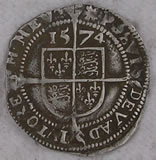

Metal detecting holidays in England with the World's most successful metal detecting club.
Twinned with Midwest Historical Research Society USA
|
Oct 2006 Latest finds page 3 New finds page 4 created |
  |
 |
||
|
Huge,
James 1st Scottish Merk sometimes known as the half thistle dollar and
value of 13 shillings and 4 pence
( 160 pence)
6.56g, 31.40mm |
Post
medieval plain strap end
|
||
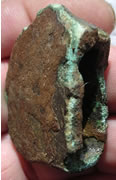  |
 |
||
|
c
850BC Bronze age axe head 44,44g 29.54mm L x 41.81mm w x 15.03mm t
|
14th/15th
copper alloy chest handle - rare to find one complete
|
||
|
|
 |
||
|
1204/5 AD King John hammered silver short cross Class 5 - 1.07g, 19.15mm |
1640's
Charles 1st hammered copper farthings
|
||
|
|
|||
|
Early decorated lead cup thought to be used for blood letting and pharmaceutical use, 62.29mm dia |
|||
  |
 |
 |
|
|
1586 Hans Krauwincel II Rose orb Jeton HANNS KRAVWINCKEL IN NVRENB |
1819
George III milled silver sixpence
|
||
|
|
|
||
|
Huge
Roman bronze key 56.66mm L35.47 mm w 11.73mm t, 55.86g
|
1.78g, 20.39mm 1434- 1435 Henry VI hammered silver half groat (2 pence) HENRIC DIN GRA REX ANGL Z FRANC HYB - leaf mascle type - Calais mint |
||
|
|
 |
 |
|
|
Stunning
1574 Elizabeth 1st hammered silver three pence
|
Bedfordshire
button
|
21st
Lancers badge
|
|
 |
 |
 |
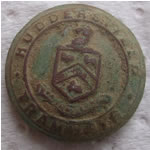 |
|
Blackburn
button
|
Crown
military button
|
Pre
1840 Navy button
|
Hudderfield
button
|
  |
|||
|
1697
William III milled silver halfcrown (30 pence)
|
|||
  |
  |
||
|
1327 Edward III hammered silver penny - Canterbury mint - Lombadic N'S - 1.26g, 17.69mm ob EDWAR ANGL DNS HYB Rev CIVIAS CANTOR |
1216 Henry III hammered silver voided long cross penny | ||
 |
 |
||
|
Complete
Georgian watch winder
|
Interesting
lead strap end
|
||
  |
  |
||
|
1594-6
Elizabeth 1st hammered silver sixpence
|
1560-1 Elizabeth 1st hammered silver shilling (12 pence) Sixth issue Marlett mint mark - rarer large bust with pearls on bodice type |
||
 |
  |
 |
|
|
16th/17thC
clothing fastener
|
1594-6
Elizabeth 1st hammered silver half groat (2pence)
|
Early
lead toy soldier - look like US civil war !
|
|
  |
  |
||
|
1866
Napolean III milled silver 1 Franc
|
1204/5
AD King John hammered silver short cross
penny
|
||
  |
 |
 |
|
|
'Given
the size, weight and portrait, that would be an As of either Marcus
Aurelius or his son Commodus - of recent, if not particularly historically
accurate fame from the movie "Gladiator".Without at least
a few letters of legend to try to hang the ID upon, I'd say it's somewhat
more likely to be Aurelius. Their years:Marcus Aurelius - 161-180 A.D.Commodus
- 177-192 A.D. (but to have this, more mature portrait, if this coin
is Commodus, it must be from the later part of his reign.
The reverse lacks the crucial bits that would show what the figure standing on the reverse is holding or doing. Whatever this might be, it seems to be taking place over an altar, so reasonable guesses might be Salus feeding her pet snake or Pietas sprinkling incense'. Mark |
18thC
decorated clog fastener
|
Medieval
silver hawking bell fragment with maker MB - reported to museum as treasure
|
|
  |
  |
||
|
1647
Commonwealth hammered silver penny
|
17thC
trade farthing - not ID'd yet
|
||
  |
 |
||
|
1719
George 1st dump farthing in great shape
|
17thC
riveted hamdle
|
||
 |
 |
 |
 |
|
Post
medieval belt mount
|
Post
medieval belt mount
|
Georgian
watch winder
|
Georgian
buckle
|
 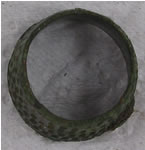 |
|||
|
Medieval
bronze open topped thimble
|
|||
 |
  |
||
|
Post
medieval book clasp
|
1668
Alex Satterthwaite of Colchester hammered copper 1/2 penny
|
||
 |
 |
  |
|
|
1640
Charles 1st hammered copper Rose farthing
|
Charles
1st hammered silver penny
|
||
 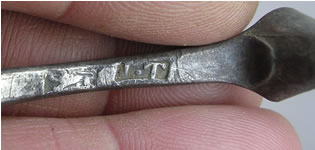 |
|||
|
Mid
18thC silver spoon with Lion hall mark and maker LT
|
|||
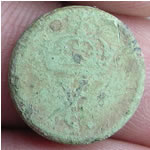  |
  |
||
|
1660
Charles II gold half guinea coin weight
|
German
Thaler copper coin
|
||
 |
 |
||
|
18th/19th
C silver cuff links
|
18th/19th
C silver cuff links
|
||
 |
  |
||
|
16th/17thC
clothing fastener
|
1461-4
Edward IV hammerd silver penny
|
||
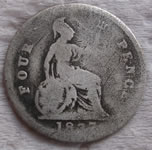  |
 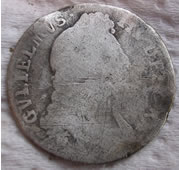 |
||
|
1837
William IIII milled silver four pence
|
1696
William III milled silver shilling (12 pence)
|
||
 |
  |
||
|
Bronze
Roman key 41.19g, 55.95mm L
|
18thC fob seal with head and anchor, probably belonged to a ships captain.
|
||
  |
|||
|
Roman
bronze hanging pendant 24.8g, 56.63mm L x 26.25mm w (possibly Bronze
Age)
|
|||
 |

|
 |
|
|
Lead
Lion - difficult to date
|
Navy
button
|
1774
pattern 80th regiment of foot
|
|
  |
 |
 |
|
|
1307 Edward II hammered silver groat EDWARDVS DI GRA REX ANGLE CIVIAS LONDON 2.17g, 22.72mm |
Medieval
clothing fastener
|
1620
pattern buckle
|
|
 |
  |
||
|
18thC
toy cannon
|
1665
Charles II Spanish colonial 1/2 Real (Mexico city mint)
|
||
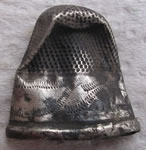 |
 |
|
|
|
Georgian
decorated silver thimble
|
1690's
William and Mary trade weight with London hall mark sword and ewer
|
17thC Madonna and child silver brooch 6.60g,19.92mm reported to museum as treasure |
|
 |
 |
||
|
Rare
1704 Queen Anne milled silver sixpence love token (S shaped)
|
c12thC
Medieval enameled gold and red harness shield pendant. 45.53mm L 28.70mm
w.
|
||
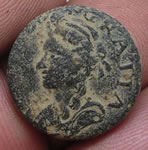  |
  |
||
|
Very
rare Queen Anne 1 guinea gold coin weight
|
Crispy
13thC Edward hammered silver penny
|
||
  |
|||
|
1199
King John hammered silver half penny
|
|||
  |
 |
 |
|
|
17thC
hammered copper trade token
|
Medieval
mount
|
Monogrammed
button with crown
|
|
  |
  |
||
|
1640
Scottish Charles 1st hammered silver 20 pence
|
1640
Charles 1st hammered copper Rose farhting
|
||
 |
 |
 |
|
|
Georgian
silver watch winder
|
Gaming
token
|
NYR
Co button
|
|
 |
 |
  |
|
|
18thC
- 2 Dram apothocaries weight
|
Medieval
lead trade weight
|
1696
William III milled silver shilling overstamped love token
|
|
  |
 |
||
|
1
shilling Oppington in Kent token
|
Roman
style key but much later in date 18thC
|
||
  |
  |
||
|
1696
William III milled silver shilling
|
1846
Victorian milled silver 4 pence
|
||
  |
  |
||
|
1645
Charles 1st hammered silver 2 pence
|
1816 George III milled silver 6 pence
|
||
 |
 |
 |
|
|
13thC
bronze key fragment
|
Lead
medieval mount
|
Possible
medieval jester hanger
|
|
 |
 |
 |
|
|
George
II trade weight with London hall mark sword and ewer
|
Colchester
Corporation button
|
Medieval
bronze purse bar with decorated finials
|
|
 |
 |
 |
|
|
WWII
Royal Air force
|
Lead
toy plane
|
Great
find 150 million BC - Dino the Dinosaur plastic toy LOL
|
|
 |
 |
  |
|
|
Large
masonic lodge badge ?
|
George
II trade weight with London hall mark sword and ewer
|
1816
George III milled silver 6 pence
|
|
 |
 |
 |
|
|
16th/17thC
clothing fastener
|
16th/17thC
clothing fastener
|
Medieval
lead seal matrix - not deciphered legend yet
|
|
  |
  |
||
|
c 1550-1585 Rose/orb anonymous issues GVBENVE |
Charles
1st Royal farthing - Harp Type 3 Maltravers 'rounds' 1634- 36
|
||
 |
  |
||
|
Roman
gilded fruit spoon - note the latch for hanging it on the side of the
bowl
|
1351-2 Edward III hammered silver groat - Cross 1 Type F Obv EDWARD D G REX ANGL Z FRANC D HYB Rev POSVI DEVM ADIVTORE MEVM (outer) CIVITAS LONDON (Mint) (inner) |
||
|
|
|
||
|
Saxon C665 - 680AD Silver Sceat 0.82 -12.19mm (EMC 2006.0336) 'After
puzzling over the reverse inscription of your second coin (EMC 2006.0336)
for some considerable time I realised this is actually a Pada type III
sceat (North 31). The reverse inscription is not as clear as it |
Saxon
C600 - 775 AD Silver Sceat, 0.94g - 11.09 mm
(EMC 2006.0335) |
||
|
'The sceat is Series F, variety bi (Metcalf, p. 129) (EMC 2006.0335). 'The other coin (EMC 2006.0336) is an interesting find, but it is not Anglo-Saxon, although it might look like an Anglo-Saxon coin. It is actually a Merovingian denier from France. The reverse design of cross and pellets is quite common in the Merovingian series, and there are traces of a diademed bust on the obverse, also typical of Merovingian deniers. I hope that it will be possible to identify this coin further from the reverse inscription, and if so I shall let you know.' ID updated above |
|||
  |
 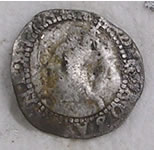 |
||
|
1564
Elizabeth 1st hammered silver sixpence
|
16th
C Elizabeth 1st hammered silver penny
|
||
 |
 |
  |
|
|
c1490-1550
The 'ship penny' type jetton:anonymous issue
|
1640
Charles 1st hammerd silver penny
|
||
  |
|||
|
This
is what has normally been referred to as a "Barbarous Radiate"
- and I say "normally referred to" because I really don't
like the term. Too many people lack the semantic subtlty to distinguish
the difference between "Barbarous" (referring to style) and
"Barbaric", thinking, perhaps, that Conan, Korgoth and their
buddies are the source of this sort of material.
Personally, I am trying to replace the term "Barbarous" - with all its pejoritive Victorian assumptions and prejudices about artistic style - with terms like "Imitative" or "Contemporary Copy" that are not quite so value-loaded. Although we are not certain why, precisely, imitative coins appeared in great numbers in several eras, I think it's safe to assume that neither the people who made nor used these were barbarians by any rational definition. There are many theories and little hard evidence to the precise "why" of these coins - some better, some worse imitations of common, circulating Roman issues, but the "where and when" are both fairly clear - at the borders of Empire and approximately contemporaneous with their prototypes. One of the most fertile places and times for their production was mid-late 3rd century Britain and northern Gaul - during the time of the Gallic Roman Empire founded when Postumus split away from Valerian and Gallienus' tottering central Roman administration. This coins seems to have used a billon antoninianus of Tetricus I as its prototype. Since all we have for legend is "IMP........PF AVG" and a bearded portrait, it could also have been in imitation of several other folks - since all the Gallic emperors struck PAX AVG types. Indeed the Pax Avg type was the most common type among both the official and imitative coinages, and Tetricus' ants were the most commonly copied. Typically smaller and somewhat cruder (some have blundered or totally illiterate legends although some are as good as or better than their prototypes), these may have been emergency issues to replace dwindling stocks of regal coin when it became unavailable, they may have been "plantation tokens" on lage latifundia - meant to be circulated only locally and/or to be redeemed in regal coin. Or they may have been out-and-out counterfiets, made to deceive - however this seems unlikely since they are typically so much smaller and cruder than their prototypes. This piece is of fairly good size (these are found down to 8 or 10 mm diameter) and style, and might even be a crude official piece, but I strongly suspect it is a contemporary copy. Mark |
|||
 |
  |
 |
|
|
19thC
Silver mount
|
1706
Queen Anne milled silver sixpence - rarer find
|
Livery
button
|
|
  |
 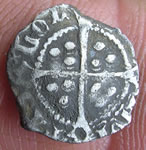 |
||
|
1586 Hans Krauwincel II Rose orb Jeton HANNS KRAVWINCKEL IN NVRENB |
Medieval hammered silver halfpenny 0.36g, 12.22mm Weight of an Edward IV 1464- 70, not confirmed ID yet rev CIVITAS LONDON |
||
|
|
|||
 |
|||







